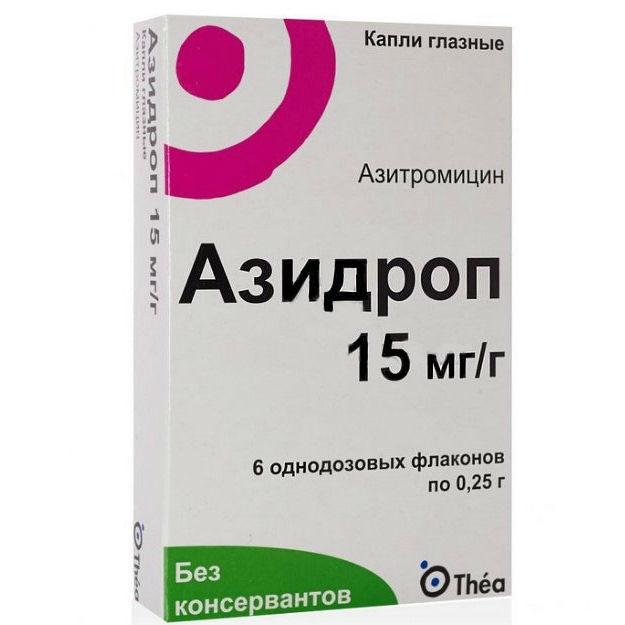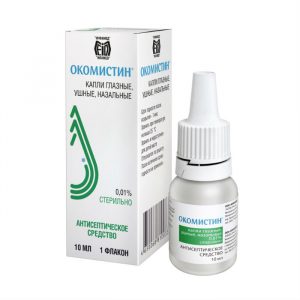Description
Latin name
AZIDROP
Release form
Azidrop ophthalmic drops. Eye drops in the form of a transparent oily liquid from colorless to light yellow in color.
Packaging
0.25 g – low-density polyethylene bottles (6) single-dose, soldered together in the form of a tape of 6 fl. – bags of combined material (1) – packs of cardboard.
Pharmacological action of
Azithromycin is a broad-spectrum antibacterial agent belonging to the class of azalides, inhibits protein synthesis, binds to the 50S subunit of ribosomes, slows the growth and reproduction of bacteria, and has a bactericidal effect in high concentrations. It acts on extra- and intracellular pathogens. Active against gram-positive microorganisms: Streptococcus spp. (groups C, F, and G, except for those resistant to erythromycin), Streptococcus pneumoniae, Streptococcus pyogenes, Streptococcus agalactiae, Streptococcus viridans, Staphylococcus epidermidis, Staphylococcus aureus gram-negative bacteria, Haemophilus influenzae, strainmellella pheradellella paraffella paraffella Haemophilus ducreyi, Campylobacter jejuni, Neisseria gonorrhoeae and Gardnerella vaginalis of some anaerobic microorganisms: Prevotella bivia, Clostridium perfringens, Peptostreptococcus spp, as well as Chlamydia trachomatis, Chlamydia pneumoniae, Mycoplasma pneumumreumumumumium complexum, Buricompium burmum complex, Mycobacterium avum ermum rum complex Inactive against gram-positive bacteria resistant to erythromycin.
Pharmacokinetics
If the drug is used twice a day, a sufficient therapeutic concentration of azithromycin in the lacrimal fluid is provided. The half-life of tear fluid is about 12 hours. The concentration of azithromycin in blood plasma after instillation of eye drops of Azidrop in the recommended dose is less than the detection threshold (less than 0.0002 μg / ml).
Indications
Treatment caused by drug-sensitive pathogens, including Chlamydia trachomatis, in adults and children from 1 year old.
Contraindications
Individual hypersensitivity to azithromycin and other macrolide antibiotics, as well as the components of the drug Azidrop age less than 1 year.
Use during pregnancy and lactation
Since the systemic exposure to azithromycin is negligible, the adverse effects of the drug during pregnancy are not expected.
It is possible to use the drug Azidrop, eye drops, for the treatment of pregnant women as prescribed by the attending physician, if the expected therapeutic effect for the mother outweighs the risk of possible side effects in the fetus.
There is limited evidence that azithromycin is excreted in breast milk, but given the low doses and low systemic availability, the effect on the body of newborns is extremely small. Thus, treatment with the use of the drug Azidrop during breastfeeding is acceptable.
Composition
1 g of eye drops contains: active substance: azithromycin dihydrate 15 mg, which corresponds to the content of azithromycin 14.3 mg,
excipients: medium chain triglycerides up to 1 g
Dosage and Administration
Topically.
Adults and teenagers (12 to 17 years old), children (2 to 11 years old)
instill one drop in the conjunctival sac of the affected eye twice a day (morning and evening) for three days.
If there is no positive trend within 3 days of using the drug, you should consult your doctor and review the treatment.
For children (1 to 2 years old)
Dosage adjustment is not required in the treatment of trachomatous conjunctivitis.
There is insufficient experience in the treatment of purulent bacterial conjunctivitis using Azidrop eye drops in children under 2 years of age.
Children up to one year old
There is not enough experience in the treatment of trachomatous conjunctivitis and purulent bacterial conjunctivitis using Azidrop eye drops in children under the age of one year.
In the elderly
, elderly patients do not require dose adjustment.
Patients should follow these guidelines:
must be washed thoroughly before dripping drops and after the
procedure, do not touch the eyes and eyelids with the tip of the dropper bottle of
after a single use, the dropper tube must be discarded with the remaining residue. Do not use the remaining solution in the dropper tube for the next instillation.
Side effects
Side effects observed during studies of the drug Azidrop, eye drops, systematized in accordance with the classification of the World Health Organization (WHO) by frequency of occurrence: very often (more than 1/10) often (more than 1/100, less than 1/10) infrequently (more than 1/1000, less than 1/100), rarely ( more than 1/10000, less than 1/1000) and very rarely (less than 1/10000).
Immune system disorders: very rarely – hypersensitivity, angioedema (Quincke’s edema).
Disorders from the eyes: very often – eye discomfort (itching, burning, tingling) after instillation of the drug often – blurred vision, sensation of sticking of eyelids, foreign body in the eye infrequently – lacrimation is very rare – eczema, erythema, swelling of the eyelids, eye allergy, conjunctival hyperemia, allergic conjunctivitis, conjunctivitis, keratitis.
Overdose
No overdose information is available.
Azithromycin is in a single-use package sufficient to treat both eyes, but not enough to cause adverse reactions after accidental intravenous administration or ingestion.
Storage conditions
Store at a temperature not exceeding 25 ° C. Keep out of the reach of children.
Expiration of
18 months
Deystvuyuschee substances
Azithromycin
dosage form
dosage form
eye drops




